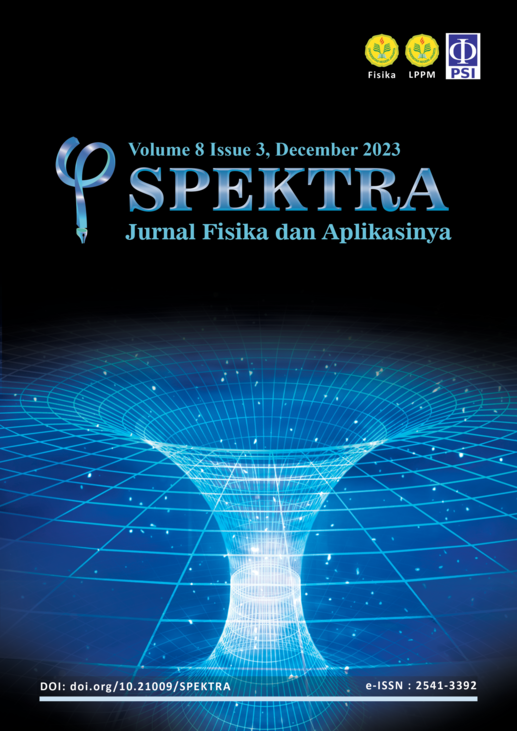SYNTHESIS AND CHARACTERIZATION ANALYSIS OF FE3O4/SiO2 CORE SHELL
DOI:
https://doi.org/10.21009/SPEKTRA.083.04Keywords:
core shell, stober, crystal structure, magnetizationAbstract
Fe3O4/SiO2 core shell synthesis has been carried out, and its characteristics has been analyzed to be used as a photocatalyst using co-precipitation and sol-gel method. Fe3O4 is used as the core material to eliminate the difficulty of separating the photocatalyst powder from the solution medium, SiO2 is used to avoid oxidation by preventing the Fe3O4 core from coming into direct contact with the solution. The samples were then characterized using X-Ray Diffraction (XRD), Fourier Transform Infra-Red (FTIR), and Vibrating Sample Magnetometer (VSM). The XRD and FTIR results showed that the crystal structure and movement of the sample molecules matched the standard characteristics from previous studies. The VSM characterization results show that SiO2 succeeded in reducing the value of the magnetization of Fe3O4, which proves that Fe3O4 has been successfully coated by SiO2.
References
[2] J. Dobson, “Magnetic Nanoparticles For Drug Delivery,” Drug Development Research, vol. 67, no. 1, pp. 55-60, 2006.
[3] Teng Ong et al., “Photodegradation of Commercial Dye, Methylene Blue Using Immobilized TiO2,” International Conference on Chemical, Biological and Environmental Engineering, vol. 43, no. 23, pp. 109-113, 2012.
[4] M. S. Manojkumar, S. Mohan, C. Thangamani, and V. Shanmugam, “Removal of heavy metals by using magnetically reusable Fe3O4@ZnO nanocomposites from Andrographis paniculata leaf extract: a greener way to remove industrial effluents,” J. Iran. Chem. Soc., vol. 20, no. 11, pp. 2767–2779, 2023, doi: 10.1007/s13738-023-02874-y.
[5] L. Dong et al., “A review on recent advances in the applications of composite Fe3O4 magnetic nanoparticles in the food industry,” Crit. Rev. Food Sci. Nutr., vol. 64, no. 4, pp. 1110–1138, Feb. 2024, doi: 10.1080/10408398.2022.2113363.
[6] Munasir et al., “Phase and magnetic properties of Fe3O4/SiO2 natural materials-based using polyethylene glycol media,” IOP Conference Series: Materials Science and Engineering, vol. 515, no. 1, p. 012017, 2019.
[7] Zaytseva et al., “Fe3O4/SiO2 Core Shell Nanostructures : Preparation and Characterization,” Russians Journal of Inorganic Chemistry, vol. 63, no. 12, pp. 1684-1688, 2018.
[8] Z. Zhang et al., “Highly efficient piezotronic strain sensors with symmetrical Schottky contacts on the monopolar surface of ZnO nanobelts,” Nanoscale, vol. 7, no. 5, pp. 1796-1801, 2015, https://doi.org/10.1039/c4nr05597g.
[9] Hakan et al., “Synthesis, characterization of Fe3O4@SiO2@ZnO composite with a coreshell structure and evaluation of its photocatalytic activity,” Journal of Environmental Chemical Engineering, vol. 8, no. 5, p. 104160, 2020.
[10] Raganata et al., “Sintesis Fotokatalis Nanopartikel ZnO untuk Mendegradasi Zat Warna Methylene Blue,” Chemistry Progress, vol. 12, no. 2, 2019.
[11] P. K. Jal et al., “Synthesis and characterization of nanosilica prepared by precipitation method,” Colloids and Surfaces A: Physicochemical and Engineering Aspects, vol. 240, no. 1-3, pp. 173-178, 2004.
[12] N. A. Galedari, M. Rahmani, M. Tasbihi, “Preparation, characterization, and application of ZnO@ SiO 2 core–shell structured catalyst for photocatalytic degradation of phenol,” Environmental Science and Pollution Research, vol. 24, pp. 12655-12663, 2017.
[13] Munasir et al., “Nanosized Fe3O4/SiO2 core-shells fabricated from natural sands, magnetic properties, and their application for dye adsorption,” Engineering and Applied Science Research, vol. 49, no. 3, pp. 340-352, 2022.
[14] Septiyani et al., “Efektivitas model inkuiri berbantuan modul dalam meningkatkan pemahaman konsep dan keterampilan generik sains,” Jurnal inovasi pendidikan kimia, vol. 8, no. 2, 2014.
[15] M. A. Ghasemzadeh, “Fe3O4@ SiO2-OSO3H nanocomposite as an efficient catalyst for the preparation of tricarboxamides,” Quımica Nova, vol. 40, pp. 47-53, 2017.
Downloads
Published
How to Cite
Issue
Section
License
SPEKTRA: Jurnal Fisika dan Aplikasinya allow the author(s) to hold the copyright without restrictions and allow the author(s) to retain publishing rights without restrictions. SPEKTRA: Jurnal Fisika dan Aplikasinya CC-BY or an equivalent license as the optimal license for the publication, distribution, use, and reuse of scholarly work. In developing strategy and setting priorities, SPEKTRA: Jurnal Fisika dan Aplikasinya recognize that free access is better than priced access, libre access is better than free access, and libre under CC-BY or the equivalent is better than libre under more restrictive open licenses. We should achieve what we can when we can. We should not delay achieving free in order to achieve libre, and we should not stop with free when we can achieve libre.
 SPEKTRA: Jurnal Fisika dan Aplikasinya is licensed under a Creative Commons Attribution 4.0 International License.
SPEKTRA: Jurnal Fisika dan Aplikasinya is licensed under a Creative Commons Attribution 4.0 International License.
You are free to:
Share - copy and redistribute the material in any medium or format
Adapt - remix, transform, and build upon the material for any purpose, even commercially.
The licensor cannot revoke these freedoms as long as you follow the license terms.

 E-ISSN 2541-3392
E-ISSN 2541-3392  Focus & Scope
Focus & Scope  Editorial Team
Editorial Team  Reviewer Team
Reviewer Team  Author Guidelines
Author Guidelines  Article Template
Article Template  Author Fee
Author Fee  Publication Ethics
Publication Ethics  Plagiarism Policy
Plagiarism Policy  Open Access Policy
Open Access Policy  Peer Review Process
Peer Review Process  Retraction & Correction
Retraction & Correction  Licensing & Copyright
Licensing & Copyright  Archiving & Repository
Archiving & Repository  Contact
Contact  Mendeley
Mendeley 

